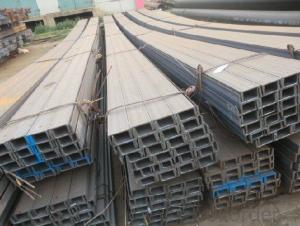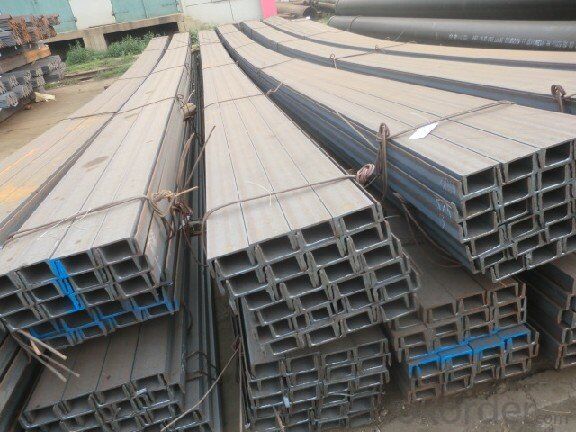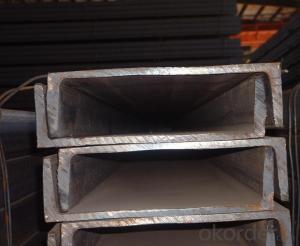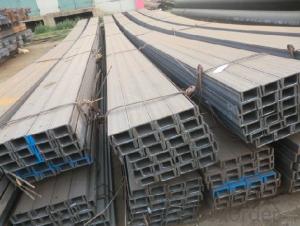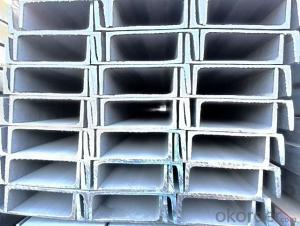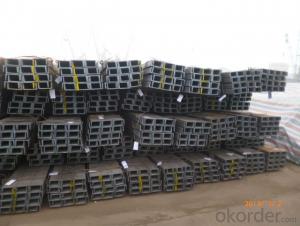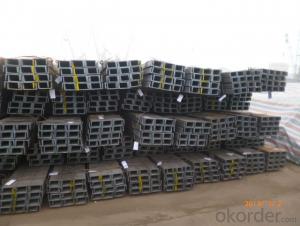Hot Rolled U-Channels with Good Quality and Best Price
- Loading Port:
- Tianjin
- Payment Terms:
- TT OR LC
- Min Order Qty:
- 25 m.t
- Supply Capability:
- 10000 m.t/month
OKorder Service Pledge
OKorder Financial Service
You Might Also Like
Specification
Okorder.com is a professional materials & equipment supplier & manufacturer, offers integrated one-stop services including real-time quoting and online cargo tracking. We are funded by CNBM Group, a Fortune 500 enterprise and the largest materials & equipment firm in China.
Product Applications:
Hot Rolled U-Channels are ideal for structural applications and are widely used in the construction of buildings and bridges, and the manufacturing, petrochemical, and transportation industries.
Product Advantages:
OKorder's U-Channels are durable, strong, and resist corrosion.
Main Product Features:
· Premium quality
· Prompt delivery & seaworthy packing (30 days after receiving deposit)
· Corrosion resistance
· Can be recycled and reused
· Mill test certification
· Professional Service
· Competitive pricing
Product Specifications:
Manufacture: Hot rolled
Grade: Q235/SS400
Certificates: ISO, SGS, BV, CIQ
Length: 6m – 12m, as per customer request
Packaging: Export packing, nude packing, bundle
JIS U CHANNEL | Standard | Sectional | Dimension |
| Mass: |
(mm) | (mm) | (mm) | (mm) | ||
50x25 | 50 | 25 | 3.0 | 6.00 | 2.37 |
75X40 | 75 | 40 | 3.8 | 7.00 | 5.30 |
75X40 | 75 | 40 | 4.0 | 7.00 | 5.60 |
75X40 | 75 | 40 | 4.5 | 7.00 | 5.85 |
75X40 | 75 | 40 | 5.0 | 7.00 | 6.92 |
100X50 | 100 | 50 | 3.8 | 6.00 | 7.30 |
100X50 | 100 | 50 | 4.2 | 6.00 | 8.03 |
100X50 | 100 | 50 | 4.5 | 7.50 | 8.97 |
100X50 | 100 | 50 | 5.0 | 7.50 | 9.36 |
125X65 | 125 | 65 | 5.2 | 6.80 | 11.66 |
125X65 | 125 | 65 | 5.3 | 6.80 | 12.17 |
125X65 | 125 | 65 | 5.5 | 8.00 | 12.91 |
125X65 | 125 | 65 | 6.0 | 8.00 | 13.40 |
150x75 | 150 | 75 | 5.5 | 7.30 | 14.66 |
150x75 | 150 | 75 | 5.7 | 10.00 | 16.71 |
150x75 | 150 | 75 | 6.0 | 10.00 | 17.90 |
150x75 | 150 | 75 | 6.5 | 10.00 | 18.60 |
150x75 | 150 | 75 | 6.5 | 10.00 | 24.00 |
200X80 | 200 | 80 | 7.5 | 11.00 | 24.60 |
The sections in details are as followings in the table-1
FAQ:
Q1: Why buy Materials & Equipment from OKorder.com?
A1: All products are carefully selected from China's most reliable manufacturing enterprises. Through its ISO certifications, OKorder.com adheres to the highest standards and a commitment to supply chain safety and customer satisfaction.We can guarantee the quality!
Q2:What's your payment terms ?
A2: We can accecpt T/T,LC at sight and time LC.
Q3: Can you supply special size ?
A3: Yes, we can produce them as per buyers' requirement and all the standard are available for us .

- Q: Can steel channels be used in data center construction?
- Yes, steel channels can be used in data center construction. Steel channels are commonly used for structural support and framing in various construction projects, including data centers. They provide strength and stability to the infrastructure, ensuring the safe installation and operation of data center equipment.
- Q: Channel 10, 1 meters. What is the theoretical weight?
- Channel 10, 1 meters, theoretical weight is 10.007kg.
- Q: Which kind of wind resistance is better for square tube, square tube or channel steel?
- Why don't you buy square tubes directly? How do you budget?
- Q: Can steel channels be used for scaffoldings?
- Yes, steel channels can be used for scaffoldings. Steel channels are commonly used in the construction industry for various applications, including scaffolding systems. They provide excellent strength, durability, and load-bearing capabilities, making them a suitable choice for supporting workers and materials at elevated heights. Steel channels can be easily assembled and disassembled, allowing for flexibility and adaptability in scaffold design. Additionally, their corrosion resistance properties make them ideal for outdoor use, where exposure to weather elements is a concern. Overall, steel channels offer a reliable and sturdy solution for scaffoldings, ensuring the safety and stability of workers and the construction project.
- Q: The reinforced welding off? Can the channel steel locked with expansion screws be taken out?
- 1, if you are eager to get down, go to the nearby hardware store, borrow a hand cutting machine, very small, very convenient! 35 minutes away; if you have the time to buy hacksaw ah!2, you find a wrench to remove the nut on the chant, if rust is not turned off, and then go to the hardware store for a grinder, two or three minutes to fix!
- Q: You design expert asked: do barrier 5 meters, how long the channel to bear?
- With 10 channel (GB) between 800 to 1000 longitudinal horizontal laying, select the 5# angle, the middle span up to 7M without support (pillar). Compares the aspect to the full use of meters. With No. 10 square tube pitch 610--810 survived, white painted with the suitable iron staircase is beautiful. The ceiling also save cost, also there are no pillars stairs is a good point. I think I've seen a picture in the post, is to use local square steel tubes do, sensory or good.
- Q: How is the hollow tempered glass mounted on the channel steel?
- Hollow two pieces of glass, there are 4 faces, from outdoor to indoor is defined as 1-4, Low-E glass film surface can only be in the cavity, that is, can only be second or third.Colorless, highly permeable Low-E is placed on third sides (Low-E glass indoors), colored on second sides (Low-E glass outside).In order to prevent the broken glass debris, doubling down side must. Because qualified laminated glass is not damaged when the debris generated, is still able to maintain its integrity.
- Q: Can steel channels be used for racking and shelving systems?
- Yes, steel channels can be used for racking and shelving systems. Steel channels are often used in the construction of industrial storage systems due to their strength and durability. They provide a sturdy framework for supporting heavy loads and can be easily customized to fit the specific dimensions and requirements of a racking or shelving system. Steel channels also offer excellent resistance to corrosion and can withstand harsh environmental conditions, making them suitable for long-term use. Additionally, their modular design allows for easy installation and reconfiguration, providing flexibility for future expansion or modification of the storage system. Overall, steel channels are a reliable and efficient choice for racking and shelving systems in various industrial and commercial settings.
- Q: Can steel channels be used for electrical wiring?
- No, steel channels are not typically used for electrical wiring.
- Q: What are the different load distribution methods for steel channels?
- There are several load distribution methods for steel channels, which are commonly used in various construction and engineering applications. These methods aim to evenly distribute load and maximize the structural integrity and strength of the channels. 1. Concentrated Load Distribution: This method involves placing the load on specific points along the steel channel. It is commonly used when there are specific areas or points that require more load-bearing capacity. 2. Uniform Load Distribution: In this method, the load is distributed uniformly along the entire length of the steel channel. It is often used when the load is evenly distributed or when there is no specific point requiring more load-bearing capacity. 3. Partial Load Distribution: This method involves distributing the load partially along the steel channel, focusing on specific sections or areas that require more strength. It is commonly used when there are varying load requirements along the length of the channel. 4. Cantilever Load Distribution: This method applies to steel channels that are fixed at one end and have the load placed at the free end. It is commonly used in structures such as bridges and balconies. 5. Distributed Load Distribution: This method involves dividing the load into smaller segments and distributing them along the length of the steel channel. It is commonly used when the load is not uniformly distributed or when there are varying load requirements at different points. 6. Point Load Distribution: In this method, the load is concentrated at specific points along the steel channel. It is commonly used when there are specific points that require more load-bearing capacity. It is important to note that the selection of the appropriate load distribution method depends on factors such as the type of structure, intended application, load requirements, and engineering specifications. It is crucial to consult with a structural engineer or design professional to determine the most suitable load distribution method for a specific steel channel application.
Send your message to us
Hot Rolled U-Channels with Good Quality and Best Price
- Loading Port:
- Tianjin
- Payment Terms:
- TT OR LC
- Min Order Qty:
- 25 m.t
- Supply Capability:
- 10000 m.t/month
OKorder Service Pledge
OKorder Financial Service
Similar products
Hot products
Hot Searches
Related keywords
